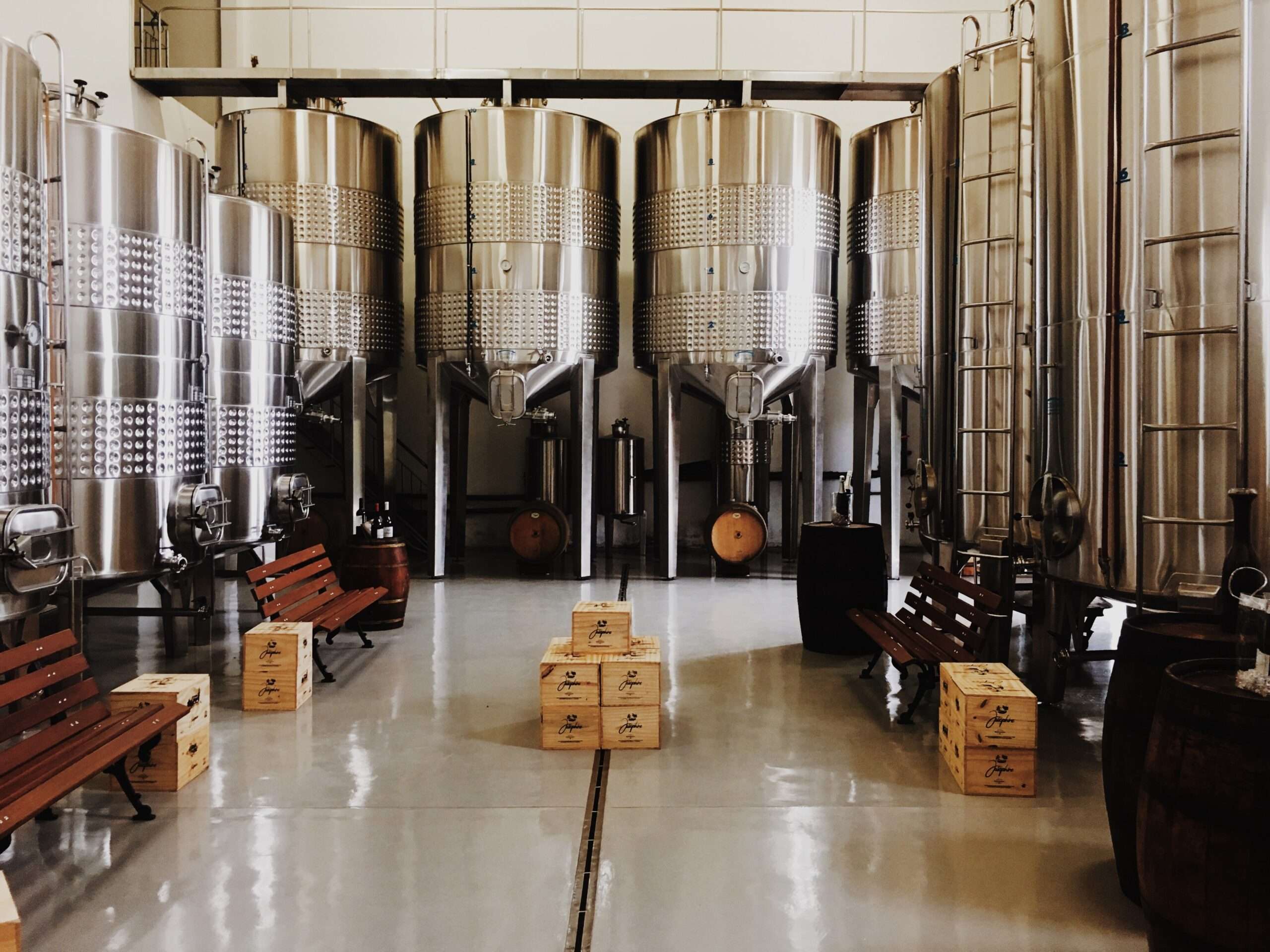The tannins unmistakably cause that puckering sensation we get from savoring red wine and tasting bitterness or dryness. Wine enthusiasts use the astringency of tannins in mostly red wines as a marker to gauge the age and quality of wines. How to reduce tannins in wines are some of the preoccupations of wine-makers and wine lovers.
Tannins give wines a bitter, dry or astringent taste. Tannins in wines lessen through in-cellar processes called fining. Once bottled, tannins are reduced through aeration in a decanter. Tannins are distinctive to red wines and refine with age. White wines matured in oak barrels have tannins.
As much as the mouth-puckering bitterness of tannins in red wines might take a refined palate to appreciate the wine, wine-makers, and enthusiasts often debate the necessity to keep these tannins in wine. Tannins naturally occur in the skins of grapes and accelerate in the wine-making process to give wines a distinctive character. From the vineyard to the cellar, tannins are essential.
The Story Of Tannins In Wine
The bitter taste in plants is often a warning to humans and animals that they are poisonous. Though bitterness can be a warning indicator, the distinctively bitter tannins in red wines are prized for a wine’s quality. Tannins in red wines (also in barrel-matured whites) are as old as wine-making. The story of tannins is also that of the vineyards, the terrain, and the climate.
Tannins are natural and present in grapes in vineyards, with the terrain affecting the tannins and eventually the character of wines. Depending on the grape varieties used, tannins have a complex chemical structure known as phenolic acids (or tannic acids). Tannins are in grape skins, seeds, and stems but also come from wines maturing in oak barrels.
Tannins in red wines (and oak matured whites) taste bitter or astringent because of their natural phenol and polyphenol compounds. That is why it feels as if our mouths dry out when we have red wines, but it’s not the same with white wines. White wines actually have low tannin levels, but red wines have much more.
Our palates and noses play a crucial part in how we taste and smell wines with the most pronounced ones the astringent (even bitter) taste of tannins. The high tannin content in red wines is as the entire grape is used – skins, pips, juice, and sometimes the stems too – which fuels the astringent sensation in our mouths when we drink red wine.
Gustatory Sensations And The Role Of Tannins
Our taste buds are part of our gustatory system, which regulates our sense of taste. We can taste sweet, sour, saltiness, savoriness, and tannins’ bitterness. Bitter flavors are unpleasant and sharp, and people associate this taste with their mouths puckering. Yet, in red wines, savoring a mouthful can be rewarding too.
There are many words used in wine-speak that refer to the taste of tannins. Mainly tannins that have been allowed to level off are rounded, silky, and smooth. These are primarily in mature wines, with the lesser mature wines referred to as green or bitter. It is not uncommon to hear wine enthusiasts speak of tannins as polished or elegant.
There are more tannins in some grape varieties than others. The bitterness in wines associated with tannins can leave our mouths feeling coated. It’ll depend on whether these tannins are left in or extracted by the wine-making technique. Wines fermented in new oak barrels can have higher tannin content as this is leaked from these barrels.
Getting To Know The Role Of Tannins In Wine
Tannins are integrated into the wines, and these are tasted as dry, astringent, or bitter. The dryness associated with the tannins in wines has a mouth-puckering sensation. The texture of wines can be velvety or down-right astringent, depending on the number of tannins. The texture of a wine is what wine enthusiasts call the mouthfeel of wines.
If tannins are ripe, wines have a structure and depth quality. This is what wine-makers strive after. Tannins mature and subtly taste with age, especially in quality wines. Controlling tannins in bottled wine can be done by letting the wine breathe before drinking these. Such aeration is necessary for a smoother taste.
Most winemakers strive for a balance in wines with harmonized tannins, acidities, and fruity flavors. Neither of these must be out of sync. As tannins often are the most dominant, wine-makers strive to have tannins balanced.
Drying Sensation Of Tannins
Tannins are the bitter sensation that we experience when we drink red wines. This sensation stands in contrast to wines with a floral or fruity taste. These bitter tastes are harsher, but as wines age, these tannins can break down due to chemical reactions and even tone down a wine’s bitterness. A high-tannin wine, however, is not a bad wine.
The simplest way to think about tannins is the contact that grape skins and seeds have with the process of making wines. As a group of bitter and astringent compounds, tannins are found in nature and grapes. In wines, the tannins are an acquired taste. Well managed during the fermentation process, tannins can be pleasant in wines.
Tannins In Red Wine
No wine tasting will happen without mentioning a few essential taste descriptors like dryness, bitterness, or the astringency of a wine. In contrast to the sweeter tone of white wines, red wines have the bitter and astringent tastes associated with the wines’ tannins. The tannins are described as the complexity of the wines.
Tannins in red wine are good for maturing wines. Many believe that tannins have anti-oxidant properties that benefit us. Storing wine in oak barrels can affect the tannins in wines. These barrel-derived tannins in red wine (sometimes whites, too) have a fine graininess on the tongue compared to the tannin from seeds, stems that are bitter, and even astringent.
Grapes in vineyards have anthocyanins (a type of flavonoid) protected from the sun by the tannins on grape skins. How much sun grapes get affects the amount of tannin in grapes. The larger the grapes grow, the less concentrated the tannins are. Wine-makers are keen to have large quantities of tannin in wines as these are what they call the backbone of good wines.
The climate affects the levels or types of tannins right from the vineyard stage. In cooler temperatures where grapes are picked earlier, these have more astringent tannins. The grapes from warmer areas are often picked later, and though these are more developed, the tannins are softer and less astringent.
In wine-making, the tannins are the phenolic compounds we associate with an excellent red wine that can be stored. There are different stages in which tannins come to the fore, either as part of the wine-making process or when we savor wines. White wines have fewer tannins (and lower concentrations), and the aging of these depends on their acid and sugar levels.
Tannins are a collective term for various phenolic compounds in grapes. From a scientific perspective, the phenols in grapes are tannins’ bitter, dry or astringent tastes. The release of these taste sensations happens as the tannins mix with the saliva proteins in our mouths. Savoring wines with tannins gives us that mouth-puckering dryness.
How To Reduce Tannins In Wines
The art and finesse of wine-making is a wine-makers call, especially when deciding how much and what quality of tannins are needed. The first release of tannins happens in the crushing of grape skins. During the fermentation stage, the seed tannins are released. As the concentration of alcohol during fermentation increases, more tannin is extracted from the skins, seeds, and bark.
Much of the interest is in why tannins are essential in wines and also how to reduce tannins. Tannins are present in grapes in vineyards, and often debate about how much tannin to leave in wine surfaces during the wine-making stages. Removing tannins from wines is also referred to as softening wines. This process looks at the harsh tannins in red wines and how to reduce these.
Generally, wine lovers know that red wines soften with age and taste less astringent. Younger wines that are tannic can be laid down or aerated. This process of laying down wines can take several years. Wine-makers regard higher tannin content in wines as beneficial to mature wines once bottled.
From centuries ago to today, reducing or extracting tannins from wines appears relatively recent. The refinement of red wines or the softening of wines’ taste has been at the forefront of wine talk, with wine-makers (and enthusiasts) discussing the merits.
Aerating Wines To Reduce Tannins
If you suspect the wine has not aged enough and can’t wait to open it, don’t waste the wine either by writing it off as bitter if you open it and taste too much tannin. You could always try to aerate the wine before use. The most straightforward technique is to decant a bottle of wine into a wide-based decanter and let it stand for a while.
Though tannins are natural and come from grape skins, seeds, and stems, some people don’t like high tannic wines. Aeration is a way to reduce the tannins in wines, making your mouth feel less dry. This kind of aeration will not remove the tannins, but air will soften the harshness of the tannins. There are commercial aerators too you can use when pouring.
The aeration option allows the wine from a bottle to get as much exposure to air but decanting wines won’t turn a bad wine into a good one. The most that can happen by decanting wines is to soften the tannins.
Extracting Tannins From Wines In A Cellar
Wine-makers in cellars are often preoccupied with extracting tannins as early on as in the pressing of the grapes stage. This process is necessary to stabilize the tannins for the production of wines.
The above stabilization is essential as the bonds between tannins have to be stable throughout the fermentation stages. A skilled wine-maker will balance the processes and ensure how long one will be able to keep wines depending on the number of tannins present in wines. To extract tannins in the wine-making stage depends on extended maceration.
A wine-makers style will determine the structure of tannins in wines. A wine-maker would therefore oversee almost every step of the process. A wine-maker would consider the grape variety, where the grapes are grown, and make sense of these throughout the cellar until bottling the wine. This will mean that a wine-maker might even decide how to handle the number of tannins.
Fining As Chemical Process To Reduce Tannins
Fining is a way of extracting tannins from wines in the cellar stage. This is a chemical process used to alter the structure of wines. Not every winemaker will choose to do this, but there are those who do use this process to clarify and then stabilize wines. The clarification often has to do with the removal of tannins.
The fining agents react with components in the wine to form new complexes that can be separated or taken out of the wine-making process. In the case of tannins, the new bonds (with tannins) can be removed during the wine-making stage. The process of fining is not a new practice and has been used for flushing out some of the tannins in wines and wine’s bitterness before being bottled.
Wine-makers refer to the flushing out of tannins as softening wine’s taste. Not all wine-makers do this, though, as some regard this process as interfering with wine’s natural flavors and textures. The reason why others do use fining is to improve wine’s mouthfeel by reducing the astringency and bitterness associated with tannins.
Fining is a way of removing molecules like tannins, and it is done before bottling. Thing leads to a softening and improved suppleness in the wine. Some of the fining agents used in this process are:
- Gelatine. To rid wines of bitter or astringent tannins. The gelatine combines with the most aggressive tannins to flush these out. The wine that remains is softer in taste and might be thinner in texture.
- Egg white (egg albumen). A solution of egg whites is used to remove phenolic compounds associated with astringency in red wines. These proteins combine with the polymeric material in the wine, which is a fining agent in red wines.
- Bentonite. A fine clay-like aluminum silicate from volcanic ash is used to remove tannins in red wines, but to a limited extent only as this process can affect red wines’ color.
- Polyvinylpolypyrrolidone (PVPP). PVPP is a gentle fining agent that preserves wine aroma and reduces wine bitterness. This synthetic polymer minimizes the level of phenolic compounds that cause astringency in wines. PVPP is almost insoluble in wine and absorbs low-weight tannins.
Selecting the best fining agent for wine also depends on why this is needed and a wine maker’s specific style. The best wine-makers manage tannins by looking at the ripeness of the grapes and skins and knowing what type of wine they want to make. This includes reasonable control over tannins to avoid harsh or bitter tastes in red wines.
Conclusion
Wine-makers and growers alike are careful to balance tannins in wines. Tannins are much valued in producing quality wines as tannins are essential to age wines. Balancing tannins in wines means that wines would be integrated and able to withstand long-term aging. Tannins can’t be isolated but are critical components in wine.
Tannins provide structure and complexity to wines and are arguably the backbone of a good bottle of red wine.















